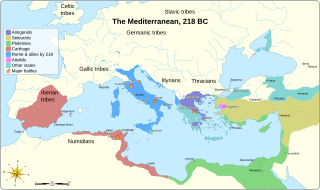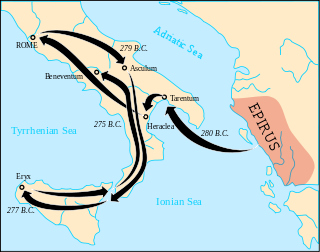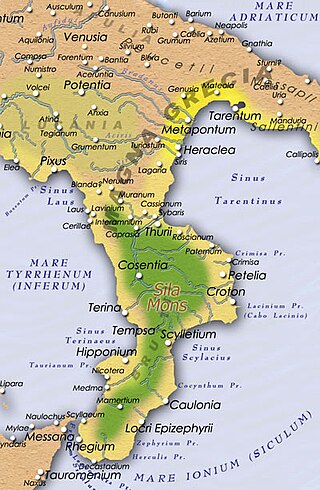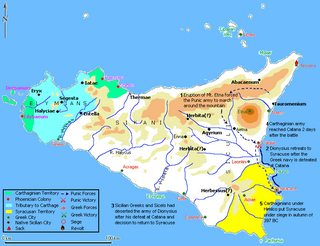
The First Macedonian War was fought by Rome, allied with the Aetolian League and Attalus I of Pergamon, against Philip V of Macedon, contemporaneously with the Second Punic War against Carthage. There were no decisive engagements, and the war ended in a stalemate.

The Battle of Cape Ecnomus or Eknomos was a naval battle, fought off southern Sicily, in 256 BC, between the fleets of Carthage and the Roman Republic, during the First Punic War. The Carthaginian fleet was commanded by Hanno and Hamilcar; the Roman fleet jointly by the consuls for the year, Marcus Atilius Regulus and Lucius Manlius Vulso Longus. It resulted in a clear victory for the Romans.
The Battle of the Aegates was a naval battle fought on 10 March 241 BC between the fleets of Carthage and Rome during the First Punic War. It took place among the Aegates Islands, off the western coast of the island of Sicily. The Carthaginians were commanded by Hanno, and the Romans were under the overall authority of Gaius Lutatius Catulus, but Quintus Valerius Falto commanded during the battle. It was the final and deciding battle of the 23-year-long First Punic War.

The Battle of Heraclea took place in 280 BC between the Romans under the command of consul Publius Valerius Laevinus, and the combined forces of Greeks from Epirus, Tarentum, Thurii, Metapontum, and Heraclea under the command of Pyrrhus, king of Epirus. Although the battle was a victory for the Greeks and their casualties were lower than the Romans, they had lost many veteran soldiers that would be hard to replace on foreign soil.

The Pyrrhic War was largely fought between the Roman Republic and Pyrrhus, the king of Epirus, who had been asked by the people of the Greek city of Tarentum in southern Italy to help them in their war against the Romans.
The naval forces of the ancient Roman state were instrumental in the Roman conquest of the Mediterranean Basin, but it never enjoyed the prestige of the Roman legions. Throughout their history, the Romans remained a primarily land-based people and relied partially on their more nautically inclined subjects, such as the Greeks and the Egyptians, to build their ships. Because of that, the navy was never completely embraced by the Roman state, and deemed somewhat "un-Roman".

The Battles of Kroton in 204 and 203 BC were, as well as the raid in Cisalpine Gaul, the last larger scale engagements between the Romans and the Carthaginians in Italy during the Second Punic War. After Hannibal’s retreat to Bruttium due to the Metaurus debacle, the Romans continuously tried to block his forces from gaining access to the Ionian Sea and cut his eventual escape to Carthage by capturing Kroton, the last port which had remained in his hands after years of fighting.

The siege of Syracuse in 397 BC was the first of four unsuccessful sieges Carthaginian forces would undertake against Syracuse from 397 to 278 BC. In retaliation for the siege of Motya by Dionysius of Syracuse, Himilco of the Magonid family of Carthage led a substantial force to Sicily. After retaking Motya and founding Lilybaeum, Himilco sacked Messana, then laid siege to Syracuse in the autumn of 397 BC after the Greek navy was crushed at Catana.
The origin of the city of Taranto dates from the 8th century BC when it was founded as a Greek colony, known as Taras.

The Battle of Ebro River was a naval battle fought near the mouth of Ebro River in the spring of 217 BC between a Carthaginian fleet of approximately 40 quinqueremes, under the command of Himilco, and a Roman fleet of 35 ships, under Gnaeus Cornelius Scipio Calvus. Hasdrubal Barca, the Carthaginian commander in Iberia, had launched a joint expedition to destroy the Roman base north of the Ebro River. The Carthaginian naval contingent was totally defeated after a surprise attack by the Roman ships, losing 29 ships and the control of seas around Iberia. The reputation of the Romans was further enhanced in Iberia after this victory, causing rebellion among some of the Iberian tribes under Carthaginian control.

The Roman Republic conquered and occupied territories in the Iberian Peninsula that were previously under the control of native Celtic, Iberian, Celtiberian and Aquitanian tribes and the Carthaginian Empire. The Carthaginian territories in the south and east of the peninsula were conquered in 206 BC during the Second Punic War. Control was gradually extended over most of the Iberian Peninsula without annexations. It was completed after the end of the Roman Republic, by Augustus, the first Roman emperor, who annexed the whole of the peninsula to the Roman Empire in 19 BC.

The Battle of Tarentum in March 212 BC was a military engagement in the Second Punic War.
Bomilcar was a Carthaginian commander in the Second Punic War.
The Battle of Messene took place in 397 BC in Sicily. Carthage, in retaliation for the attack on Motya by Dionysius, had sent an army under Himilco, to Sicily to regain lost territory. Himilco sailed to Panormus, and from there again sailed and marched along the northern coast of Sicily to Cape Pelorum, 12 miles (19 km) north of Messene. While the Messenian army marched out to offer battle, Himilco sent 200 ships filled with soldiers to the city itself, which was stormed and the citizens were forced to disperse to forts in the countryside. Himilco later sacked and leveled the city, which was again rebuilt after the war.
Agesimbrotus was the commander of the Rhodian fleet, consisting of 20 decked ships, during the Second Macedonian War, and sailed against Philip of Macedon from 200 to 197 BC. Agesimbrotus' fleet met with the 24 quinqueremes of Attalus I near Andros, and the two sailed for Euboea, and ravaged the lands belonging to Carystus. When that city received reinforcements from Chalcis, the fleets diverted to Eretria rather than engage a more prepared enemy. There they united with the fleet of Roman admiral Lucius Quinctius Flamininus, and the three of them laid heavy siege to Eretria, which surrendered after a nighttime assault by Quinctius. The three commanders sailed back to Carystus, which evacuated into the city citadel at the approach of such a fleet, and sent ambassadors to beg protection from Quinctius. The townspeople were freed and the Macedonian garrison was ransomed and deported, unarmed, to Boeotia.
Himilco was a member of the Magonids, a Carthaginian family of hereditary generals, and had command over the Carthaginian forces between 406 BC and 397 BC. He is chiefly known for his war in Sicily against Dionysius I of Syracuse.
The Roman withdrawal from Africa was the attempt by the Roman Republic in 255 BC to rescue the survivors of their defeated expeditionary force to Carthaginian Africa during the First Punic War. A large fleet commanded by Servius Fulvius Paetinus Nobilior and Marcus Aemilius Paullus successfully evacuated the survivors after defeating an intercepting Carthaginian fleet, but was struck by a storm while returning, losing most of its ships.
The Battle of Victumulae, fought in January of 217 BC during the Second Punic War, represented a clash of secondary importance, engaged between the army of consul Tiberius Sempronius Longus and the Carthage army of Hannibal, after the victories of the latter reported in Battle of Ticinus and at the Battle of Trebbia.

The Hannibal's raid to Rome occurred in 211 BC during the Second Punic War; the Carthaginian leader Hannibal marched by surprise with his army towards Rome, initially causing great concern among the leaders and citizens of the republic. The raid, however, ended in failure; soon, faced with firm resistance from the Romans, Hannibal left the city to head with his troops to Campania.

The Battle of Placentia which took place in January of 217 BC during the Second Punic War, represented a double clash of secondary importance, engaged between the army of the consul Tiberius Sempronius Longus and the Carthagese army of Hannibal, after the latter's victories at the Ticinus and at the Trebbia.











